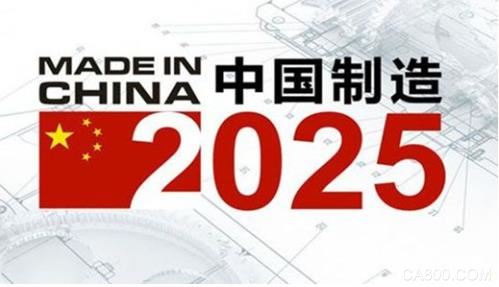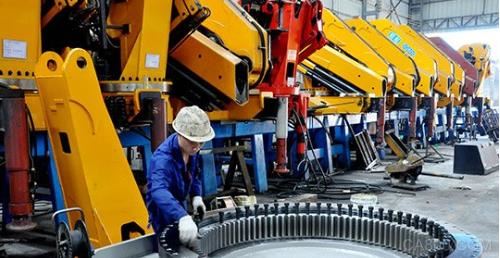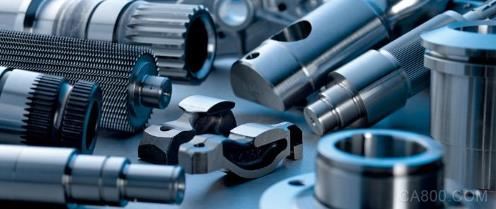Since the "Twelfth Five-Year Plan" period, my country's economic growth has entered a new normal, and the economic growth rate has shown a gradual decline. In 2015, the official promulgation of "Made in China 2025" means that the strategic upgrade of "Made in China" in the next 10 years has been put on the agenda. The document clearly pointed out the need to vigorously develop a new generation of information, aerospace and other ten key industries, and gradually promote the development of China's manufacturing industry to service-oriented and service industry to production-oriented. The new industrial development policy is bound to adapt to the current national industrial economic environment, and of course it is an inevitable choice under the new economic environment. On the one hand, the global industrial transformation and upgrading trend is remarkable. Manufacturing has once again become a pillar industry in economically developed countries. my country no longer simply pursues GDP growth, but has changed its policy objectives to adjust economic structure and promote industrial upgrading.

In terms of industrial foundation, my country has become the world's largest commodity production and trade center. The scale of commodity production in a country is directly related to the scale of commodity trade in that country, thereby affecting the status of the country's commodity industry in global industrial development and its value in the global industrial value chain. Since the late 1970s, my country has changed its traditional commodity production and trade from a small scale, and began to use the power of reform and opening up to focus on enhancing the global competitiveness of the manufacturing industry. According to relevant data, my country’s merchandise export scale in the 1980s was only 18 billion U.S. dollars, accounting for less than 1% of the global merchandise export scale. However, the merchandise export scale of developed countries such as Germany and Japan during the same period Respectively reached 10.65 times and 7.20 times of my country's export scale. After more than 30 years of reform and opening up, the scale of my country's commodity production and trade has continued to expand, and its position in the global industrial division of labor has been increasing. As of 2015, my country's commodity exports reached 14.14 trillion yuan, and the trade surplus continued to expand, becoming a veritable commodity production and trading center.
In addition, the scale advantage of my country's manufacturing industry has become increasingly significant. As the main body of my country's national economy, manufacturing industry has rapidly increased its industrial scale in the context of rapid economic growth. In terms of trade division, the export scale of my country's manufacturing industry in the early 1980s was only 8.7 billion U.S. dollars, accounting for 0.8% of global manufacturing exports, which was far from developed countries such as Germany, Japan, and the United States. In recent years, under the positive effects of the demographic dividend and the globalization dividend, my country's manufacturing industry has been greatly developed. As early as 2013, the proportion of my country's manufacturing export scale has increased from 0.8% in the 1980s to 17.53%. The proportion of manufacturing exports in many developed countries is decreasing year by year. At present, the scale of my country's manufacturing industry has surpassed the United States, Germany, Japan and other countries, and the scale advantage is very significant.
In terms of internal motivation, first, my country's industrial structure is large but weak, and regional development is uneven. At this stage, my country is the world’s largest manufacturing trade surplus country with significant scale advantages. However, on the whole, the industrialization level of manufacturing industry is still relatively low, the degree of modernization is not high, and the development of high-end manufacturing is still in a downturn, forming the current state of my country. The status quo of large but weak manufacturing industry institutions. Not only that, in terms of regional development, my country’s manufacturing industry has shown an uneven trend in the industrial distribution. The eastern coastal areas are the gathering places of manufacturing industries, and the industrial agglomeration effect and scale effect are relatively strong, while the central and western regions have relatively strong manufacturing development. Weak, the gap between east and west is obvious.
Second, my country's demographic dividend advantage has gradually weakened. Judging from the natural population growth trend, the phase characteristics of my country's population growth are obvious. In the early 1960s, during the three years excluding natural disasters, the birth rate and death rate of our country's population increased rapidly, resulting in a rapid increase in the population of children and an increase in population debt. In the 1960s and 1990s, the labor population further increased, and the dependency coefficients of the children and the elderly were relatively low, resulting in the formation of a low-cost labor force, and the demographic dividend advantage was prominent. After the 1990s, the growth rate of the labor force population decreased, and the demographic dividend was gradually transformed into a population debt. As a result, the original demographic dividend advantage is gradually weakening.
Third, pressure on the industrial structure has increased. Currently affected by the new economic normal, the evolution of the industrial structure has maintained a high degree of consistency with the economic environment. In other words, the weakening of the demographic dividend advantage brought about by the new economic normal, the slowing down of economic growth, and the imbalance of regional development also restrict the optimization and upgrading of the manufacturing industry structure. At present, my country's industrial structure has gradually changed to a tertiary industry as the leading factor, and the proportion of the industrial structure of the manufacturing industry has declined. As of 2014, the tertiary industry accounted for only 48.2%. my country's manufacturing industry is showing a low level of servitization, intelligence, and innovation, and the industrial structure is under pressure.
To realize the "Made in China" strategic upgrade under the new normal of the economy, we should make every effort

In terms of industrial foundation, my country has become the world's largest commodity production and trade center. The scale of commodity production in a country is directly related to the scale of commodity trade in that country, thereby affecting the status of the country's commodity industry in global industrial development and its value in the global industrial value chain. Since the late 1970s, my country has changed its traditional commodity production and trade from a small scale, and began to use the power of reform and opening up to focus on enhancing the global competitiveness of the manufacturing industry. According to relevant data, my country’s merchandise export scale in the 1980s was only 18 billion U.S. dollars, accounting for less than 1% of the global merchandise export scale. However, the merchandise export scale of developed countries such as Germany and Japan during the same period Respectively reached 10.65 times and 7.20 times of my country's export scale. After more than 30 years of reform and opening up, the scale of my country's commodity production and trade has continued to expand, and its position in the global industrial division of labor has been increasing. As of 2015, my country's commodity exports reached 14.14 trillion yuan, and the trade surplus continued to expand, becoming a veritable center of commodity production and trade.
In addition, the scale advantage of my country's manufacturing industry has become increasingly significant. As the main body of my country's national economy, manufacturing industry has rapidly increased its industrial scale in the context of rapid economic growth. In terms of trade division, the export scale of my country's manufacturing industry in the early 1980s was only 8.7 billion U.S. dollars, accounting for 0.8% of global manufacturing exports, which was far from developed countries such as Germany, Japan, and the United States. In recent years, under the positive effects of the demographic dividend and the globalization dividend, my country's manufacturing industry has been greatly developed. As early as 2013, the proportion of my country's manufacturing export scale has increased from 0.8% in the 1980s to 17.53%. The proportion of manufacturing exports in many developed countries is decreasing year by year. At present, the scale of my country's manufacturing industry has surpassed the United States, Germany, Japan and other countries, and the scale advantage is very significant.
In terms of internal motivation, first, my country's industrial structure is large but weak, and regional development is uneven. At this stage, my country is the world’s largest manufacturing trade surplus country with significant scale advantages. However, on the whole, the industrialization level of manufacturing industry is still relatively low, the degree of modernization is not high, and the development of high-end manufacturing is still in a downturn, forming the current state of my country. The status quo of large but weak manufacturing industry institutions. Not only that, in terms of regional development, my country’s manufacturing industry has shown an uneven trend in the industrial distribution. The eastern coastal areas are the gathering places of manufacturing industries, and the industrial agglomeration effect and scale effect are relatively strong, while the central and western regions have relatively strong manufacturing development. Weak, the gap between east and west is obvious.
Second, my country's demographic dividend advantage has gradually weakened. Judging from the natural population growth trend, the phase characteristics of my country's population growth are obvious. In the early 1960s, during the three years excluding natural disasters, the birth rate and death rate of our country's population increased rapidly, resulting in a rapid increase in the population of children and an increase in population debt. In the 1960s and 1990s, the labor population further increased, and the dependency coefficients of the children and the elderly were relatively low, resulting in the formation of a low-cost labor force, and the demographic dividend advantage was prominent. After the 1990s, the growth rate of the labor force population decreased, and the demographic dividend was gradually transformed into a population debt. As a result, the original demographic dividend advantage is gradually weakening.
Third, pressure on the industrial structure has increased. Currently affected by the new economic normal, the evolution of the industrial structure has maintained a high degree of consistency with the economic environment. In other words, the weakening of the demographic dividend advantage brought about by the new economic normal, the slowing down of economic growth, and the imbalance of regional development also restrict the optimization and upgrading of the manufacturing industry structure. At present, my country's industrial structure has gradually changed to a tertiary industry as the leading factor, and the proportion of the industrial structure of the manufacturing industry has declined. As of 2014, the tertiary industry accounted for only 48.2%. my country's manufacturing industry is showing a low level of servitization, intelligence, and innovation, and the industrial structure is under pressure.
To realize the "Made in China" strategic upgrade under the new normal of the economy, we should make every effort

Continue to accelerate innovation-driven transformation. Under the background of the current economic development stage, in order to further realize the actual needs of my country's economic growth, it is necessary to transform the traditional investment drive on the basis of fully adapting to the characteristics of the staged development of productivity, so as to promote the economic growth momentum with innovation. In the past few years, my country’s rapid GDP growth has brought about a huge industrial scale. At the same time, high investment and high cost have also caused problems such as industrial structure imbalance, industrial homogeneity, and uneven industrial distribution. It can be seen that the traditional investment economy The growth mode cannot meet the needs of current and future social and economic development. At present, my country's manufacturing industry is marching towards intelligence and innovation, and its industrial investment form should also be transformed into a way driven by innovation investment. Cultivate the main body of industrial innovation through marketization, and make full use of the market, government, and enterprises to enhance the innovation power of industrial development.
Continuously optimize the industrial value chain. As far as my country's industrial value chain is concerned, on the basis of continuous improvement of market resource allocation, it is required to realize the optimization and reconstruction of the industrial value chain. First, actively reconstruct the industrial value chain. In accordance with the new requirements of regional development, deeply implement policies such as the revitalization of the old industrial base in the Northeast and the development of the western region, and continue to promote the implementation of new economic policies such as free trade zones and the "One Belt and One Road", so as to realize the reconstruction of my country's industrial spatial layout To improve the entire industrial value chain and ensure the coordination of the interests of the industrial economy in the region. Second, actively integrate into the international industrial division of labor. By improving the layout of my country's processing trade and innovating its processing trade methods, the added value of my country's industry and the promotion of the status of international manufacturing will be achieved.
Promote the integration of manufacturing services. At this stage, the blurring of industrial boundaries and the deepening of industrial division of labor have created an inevitable trend for the development of industrial integration. The intelligent, service-oriented, and information-based development of the manufacturing industry requires in-depth integration with the service industry. In 2012, the proportion of my country's tertiary industry surpassed that of the primary and secondary industries for the first time, thus forming the core force of economic growth led by the tertiary industry. The continuous progress of the service industry also provides opportunities for the service-oriented development of the manufacturing industry. However, the level of my country's service industry is still relatively backward, especially in the development of producer services, the advantages are not obvious, such as lack of innovative knowledge, core technology, etc., which is relatively unfavorable for achieving the strategic upgrade of the manufacturing industry. Therefore, we should promote manufacturing and services. Industry integration to create a productive service industry.
Give full play to the industrial effects of regional economic policies. With the continuous reform and deepening of the economic system today, the transformation of regional economic policies from equilibrium to non-equilibrium is an inevitable result, which has successfully transformed the allocation of industrial resources into a market-led allocation structure, breaking the barriers to the flow of resource industries and regions. , While taking into account the dual goals of economic growth and regional development, improving the effectiveness of regional overall planning, and maximizing the economic benefits of regional industries. Therefore, giving full play to the industrial effects of regional economic policies is one of the important paths to promote the transformation and upgrading of manufacturing. Through the regionalization of industrial policies and the industrialization of regional policies, the economic ties between regions should be strengthened, such as the establishment of free trade zones and the "Belt and Road" economic zone. In accordance with changes in economic development goals, timely improvements are made to economic policies to make regional industrial development more rational.
